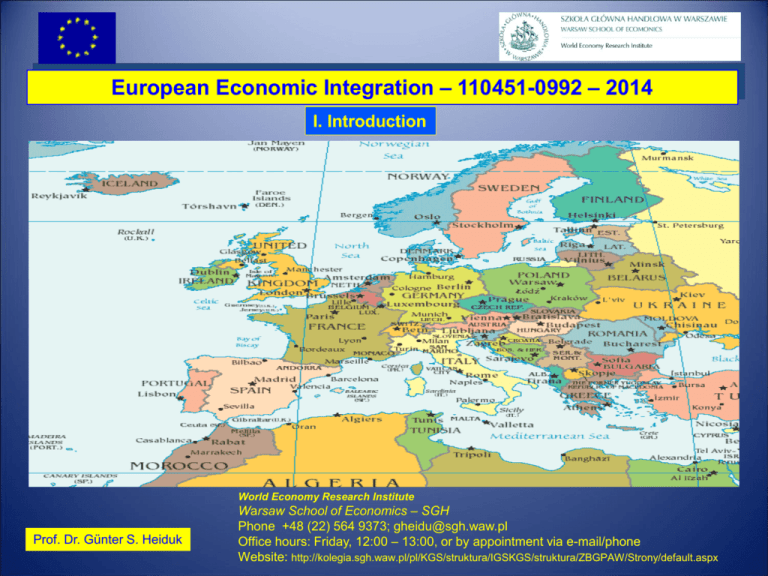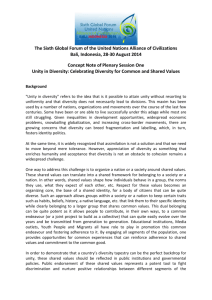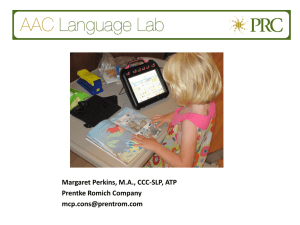The European Union
advertisement

European Economic Integration – 110451-0992 – 2014 I. Introduction World Economy Research Institute Prof. Dr. Günter S. Heiduk Warsaw School of Economics – SGH Phone +48 (22) 564 9373; gheidu@sgh.waw.pl Office hours: Friday, 12:00 – 13:00, or by appointment via e-mail/phone Website: http://kolegia.sgh.waw.pl/pl/KGS/struktura/IGSKGS/struktura/ZBGPAW/Strony/default.aspx Timetable Fr 02 - 28 09:50 - 11:30 A8 I. Introduction Fr 03 - 07 09:50 - 11:30 A8 II. Theories of Econ. Int. Fr 03 - 14 09:50 - 11:30 A8 III. EU: Deepening + Widening Fr 03 – 21 09:50 – 11:30 A8 X. Europe 2020 Dr. Marta Mackiewicz Fr 03 - 28 09:50 - 11:30 A8 IV. EU’s budget Fr 04 - 04 09:50 - 11:30 A8 V. Common Trade Policy (1) Fr 04 - 11 09:50 – 11:30 A8 V. Common Trade Policy (2) Fr 04 - 18 Fr 04 - 25 Fr 05 - 02 Fr 05 - 09 Fr 05 - 16 09:50 – 11:30 A8 Fr 05 – 23 09:50 – 11:30 A8 Fr 05 - 30 09:50 – 11:30 A8 VIII. EMU Fr 06 - 06 09:50 – 11:30 A8 IX. EU’s Sovereign Debt Crisis Fr 06 - 13 09:50 – 11:30 A8 Paper presentations Easter break 09:50 – 11:30 A8 VI. Common Agricultural Policy May holiday 06 – XX * Mgr Agnieszka McCaleb VII. Cohesion Policy EU-China Economic Relations* Exam: - Essay European Union awarded 2012 Nobel Peace Prize Thorbjorn Jagland, the chairman of the Norwegian Nobel Committee, announced the winner of the peace prize on October 12 in Oslo Share of World GDP EU-27 25.8% Source: Eurostat online data code (nama_gdp_c) and the United Nations Statistics Division (National Accounts Main Aggregates Understanding “Integration“ – Searching for “Europe“ Integration = Globalisation? Integration = Regionalisation? Integration = Regionalism? Integration = Multilaterisation? Integration = Multilateralising regionalism? ------------------------------------------------ Europe defined by geography, culture, institution? 5 -Exports - Imports “Far distance integration“ by international trade flows = Globalisation? 6 -Exports - Imports “Far distance integration“ by international trade flows = Globalisation? 7 Trade Blocs :: European Union (EU) African Union (AU) Union of South American Nations (UNASUR) Caribbean Community (CARICOM) Central American Integration System (SICA) Arab League (AL) European Free Trade Association (EFTA) Eurasian Economic Community (EAEC) Association of Southeast Asian Nations (ASEAN) Central European Free Trade Agreement (CEFTA) North American Free Trade Agreement (NAFTA) South Asian Association for Regional Cooperation (SAARC) Pacific Islands Forum (PIF) Regionalism = Institutionalized regional integration ASEAN, EU, Mercosur, NAFTA 9 Regionalism: Spaghetti bowl’ RTAs in the Western Hemisphere 10 Global, inter-regional, intra-regional trade Centeno, M and Cooke, A (2006). Introduction to the Data from GKG Project. Princeton University. Europe‘s intra- and inter-regional exports , 2012 (in %) CIS 3,8 North America 10,1 7,7 EU 68,6 3,3 Middle East 1,9 South and Central America Asia 3,3 Africa Source: WTO, International Trade Statistics Merchandise Trade of Selected Regional Trade Agreements, 2012 Total Trade (USD billion) 14000 12000 10000 8000 6000 4000 2000 0 EU-27 NAFTA ASEAN MERCOSUR Share of Intra- and Extra-Regional Exports (in %) Most of the international trade takes place within major economic blocs, notably for the EU (European Union) and NAFTA (North American Free-Trade Agreement), where 63% and 49% of their respective trade concerns member nations. While trade relations between advanced economies are linked to the emergence of economic blocks, trade relations between developing countries is often related to unilateral agreements between specific partners (particularly for former colonies). This attribute is however becoming marginal with the emergence of trade agreements involving developing countries such as Mercosur and ASEAN (Association of Southeast Asian Nations). Still, these integration agreements have a limited cohesion. For instance, only 26% of ASEAN's trade is internal. Source: WTO, International Trade Statistics 2013, Appendix Table A3. Where are the borders of Europe? 14 EUROPEAN UNION DIVERSITY IN UNITY ? UNITY IN DIVERSITY 15 The European Union: 503.5 million people (1 Jan. 2012) – 28 member states st 16 EUROPE AT NIGHT Source: Courtasy: DMSP and NASA, www.nasa.gov Symbolic description Against the background of blue sky, twelve golden stars form a circle, representing the union of the peoples of Europe. The number of stars is fixed, twelve being the symbol of perfection and unity. The flag therefore remains unchanged regardless of EU enlargements. 18 Founding fathers New ideas for lasting peace and prosperity… Alcide de Gaspari Konrad Adenauer Winston Churchill Robert Schuman Jean Monnet 19 Multilingualism: 24 official languages With a permanent staff of around 1 750 linguists and 600 support staff, the European Commission has one of the largest translation services in the world. The Commission's interpretation service employs 600 staff interpreters, a pool of 3,000 freelance interpreters and 250 support staff. Hrvatski Working languages: English, French, German 20 Eight +1 enlargements 1952-2013 1952 Eight enlargements 1973 1981 1986 1990 1995 2004 Ninth enlargement: Croatia on July 1, 2013 2007 21 Ninth enlargement 1st July 2013 and current official and potential candidates The treaties – basis for democratic cooperation built on law 1952 1958 The European Steel and Coal Community The treaties of Rome: The European Economic Community The European Atomic Energy Community (EURATOM) 1987 The European Single Act: the Single Market 2007 Treaty of Lisbon (signed) 1 Dec. 2009 into force 2003 1999 1993 Treaty of Nice Treaty of Amsterdam Treaty of European Union – Maastricht 23 The Lisbon treaty - taking Europe into the 21st century The Treaty will make the European Union: More efficient Simpler processes, full-time president for the Council, etc. More democratic Stronger role for the European Parliament and national parliaments, "Citizens initiative", Charter of Fundamental Rights, etc. More transparent Clarifies who does what, greater public access to documents and meetings, etc. More united on the world stage High Representative for Foreign Policy, etc. More secure New possibilities to fight climate change and terrorism, secure energy supplies, etc. Signed in December 2007 – entered into force on 1st December 2009. 24 How rich is the EU compared to the rest of the world? GDP per capita (PPP), Selected Countries/Regions, 2000, 2005, 2010, 2012, US$ 90000 80000 70000 EU 60000 Luxembourg 50000 Germany 40000 Romania 30000 USA 20000 Japan 10000 0 2000 Source: IMF. 2005 2010 25 GDP per capita in Purchasing Power Standards, 2012 Index where the average of the 27 EU-countries is 100 EUROSTAT, Annual National Accounts, t_nama_gdp, te00114 26 EU‘s greatest achievements Customs Union - Abolishing internal tariffs - Establishing a common external tariff Single Market Monetary Union Enlargement - Four freedoms of movement: Goods Services People Capital - European Monetary System (EMS) - Euro - Economic and political stability in Europe 27 EU‘s greatest challenges: Widening versus deepening Deepening: Lessons from the Euro crisis? 2004 2007 2015 ? 20... ? Widening 28 Future Enlargements? Acceding country: Croatia 1st July 2013 Potential candidates: Albania, Bosnia and Herzogovina, Kosovo, Serbia Candidate countries: Island, Macedonia, Montenegro, Turkey 29 The Western Balkan countries on the Road to the European Union Components of the Stabilisation and Association Process (SAP): Stabilisation and Association Agreements: A far-reaching contractual relationship between the EU and each Western Balkan country, entailing mutual rights and obligations. Such an association has high political value. It is based on the gradual implementation of a free trade area and reforms designed to achieve the adoption of EU standards with the aim of moving closer to the EU. EU Financial Assistance: Humanitarian and emergency assistance, rebuilding infrastructure, and fostering reconciliation, developing government institutions and legislation, approximation with European norms and eventually harmonisation with EU acquis (EU law), reinforcing democracy and the rule of law, human rights, operation of a free market economy, sustainable economic recovery, promoting social development and structural reform, promoting regional co-operation between the Western Balkan countries Autonomous Trade Measures: Duty-free access to the EU market for practically all products originating from the region 30 GDP PPP per capita, EU-27 = 100 Widening results in declining average GDP/capita Basic Indicators of Exports + Imports 31 Agreements in the Euro-MED Area, 2008 Schengen Agreement: Imperfect mobility for persons 33 Bulgaria, Cyprus, Romania are not yet fully-fledged members of the Schengen area. Characterizing the European Union: Diversity in Unity versus Unity in Diversity? EU-15, 2003 Characterizing the European Union: Diversity in Unity versus Unity in Diversity? EU-27, 2009 Cited: Schlecker-Fischer, A. (2010), p 23, 27. Dual Idenfication Across Groups of Member States (percentages) Source: Schlecker-Fischer, A. (2010), p .30. Boundaries versus Borders Geographical Political Cultural Economical Institutional/legal Transactional 38 Europe: Diversity in Unity ? 39 40 National identities: language, history and culture of a country 41 The Impact of Enlargement 42 Discipline perspective: Diversity in law, economics, politics, history Language § Law History, Culture € Economics Politics 43 Spread of wealth: Differences in GDP/capita Euro Area – Non-Euro Area 3 Official languages – 23 languages – 27 member states Linguistic distances, linguistic homogeneity, linguistic convergence “Hard“ law = National law - “Soft“ law = European law? National borders versus “federal vision“ National citizenship versus “pluralistic citizenship“ “Europe” is a movable set of myths and images, both positive and negative, embedded in national histories and vernacular literature.” William Wallace (2002), Where Does Europe End? Dilemmas of Inclusion and Exclusion In: Zielonka, J. (ed.), Europe Unbound…, p. 79. Europe: Unity in diversity ? “In varietate concordia” 45 European identity? Institutions and integration process in Europe Enlargement Hungary Poland Institutions Commission Parliament .... Council ECB ... Slovakia ... 46 ”Economics might be universal, but economies are not. The market economy is a theoretical construct, whose substance can only be found in real, live market economies, which are distinctive and contextually defined.” Understand interaction as well as distances & display methodological openness Educate economists to be aware of the noneconomic! 47 Conceptualizing Europe A) An institutional approach Levels of institutions Economy Horizontal and vertical interdependencies, distances, interactions Culture Nation states Law Europe west World Technology east B) A dynamic approach Evolution of Europe‘s economy, cultures, nations, law, technologies (e.g., by using a socio-dynamic method) 48 Summary: European studies without borders! Study Europe • by integrating internal and external views! • from the point of view of and through the collaboration of different disciplines! • by acknowledging unity in diversity and diversity in unity! • by successfully tearing down ideological borders and claims of dominance! 49 Nothing is possible without men, nothing is sustainable without institutions! Jean Monnet – The intellectual father of the European Union 50 51








